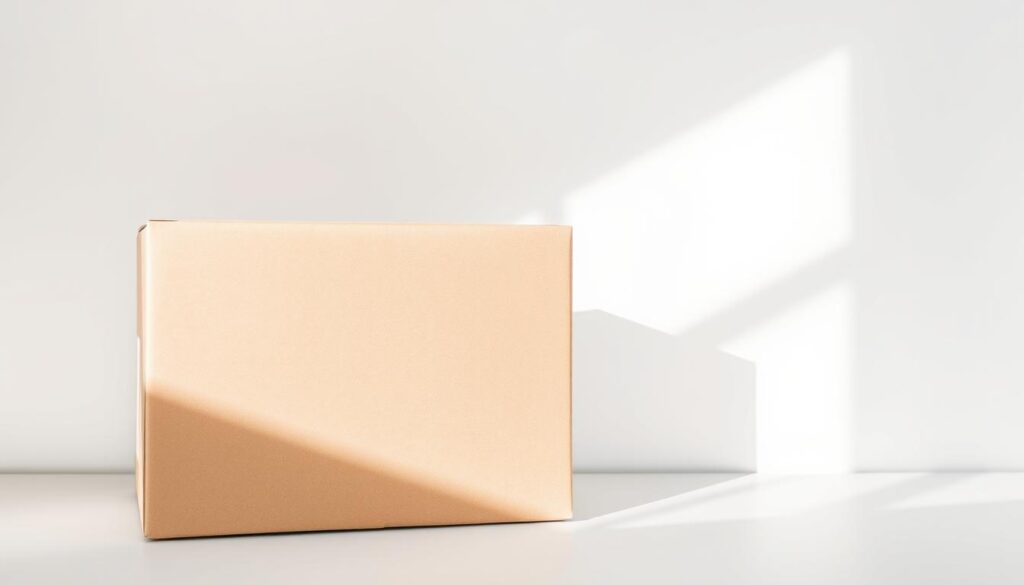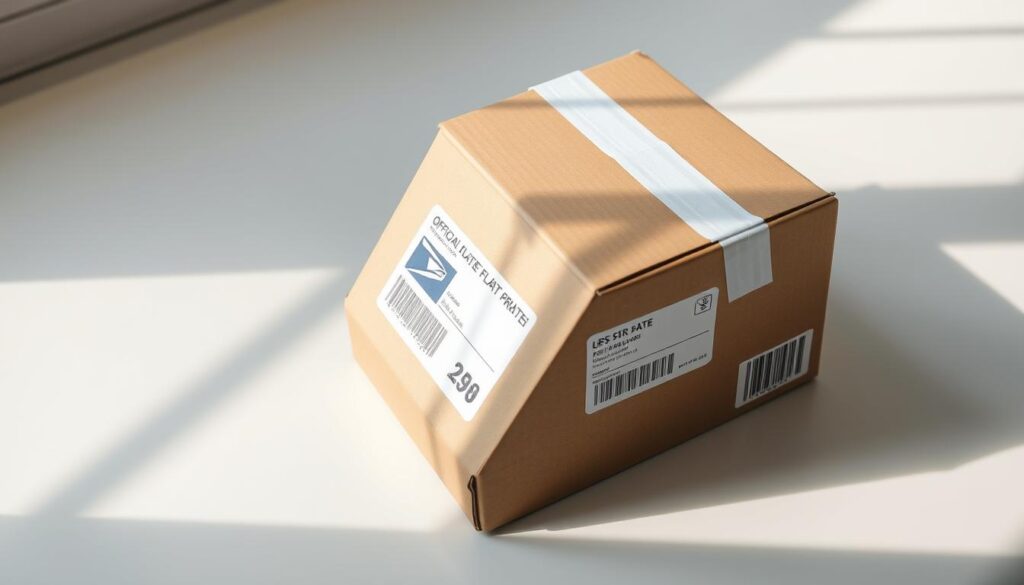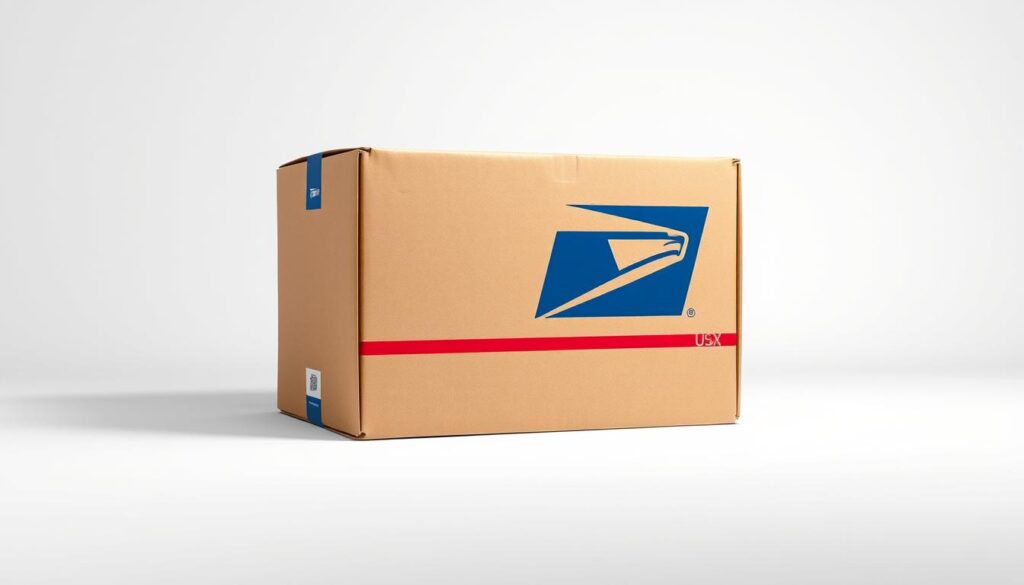Are you having trouble choosing between a flat rate box and a standard box for your shipment?
Choosing the right shipping option can greatly affect your costs and how efficient you are. The USPS says flat rate shipping is a great, easy way to send packages. It’s especially good for heavy or big items.
A standard box, however, costs based on its weight and size. This makes it a better deal for lighter packages. So, how do you pick the best one for your needs?
Key Takeaways
- Think about your shipment’s weight and size when picking between a flat rate box and a standard box.
- Flat rate shipping gives you a fixed price, no matter where you’re sending it.
- Standard boxes cost more based on weight and size.
- Your budget and shipping needs are key in choosing the right box.
- USPS flat rate boxes are perfect for heavy or big items.
Understanding Shipping Box Options
Get ready to learn about the different shipping box options. Knowing your options is key for efficient and cost-effective shipping. The right packaging box can prevent damage, cut shipping costs, and make customers happy.
The Importance of Choosing the Right Box
Choosing the right shipping box is crucial. It ensures your items arrive safely and on time. A good box can also save you money by reducing weight charges and avoiding extra fees.
Overview of Available Shipping Container Types
Carriers like USPS, FedEx, and UPS have many postal shipping box options. The main types are:
- Flat rate boxes
- Standard boxes
- Custom boxes
Let’s look at the main shipping box types:
| Box Type | Pricing Structure | Size Options |
|---|---|---|
| Flat Rate | Fixed rate regardless of weight or destination | Pre-defined sizes |
| Standard | Based on weight and dimensions | Various sizes available |
| Custom | Varies by carrier and specifications | Customizable sizes |
Each box type has its benefits. By understanding these, you can choose the best for your shipping needs.
What Is a Flat Rate Box?
A flat rate box makes shipping easier. You pay the same price for every package, no matter the weight or where it goes. The item just needs to fit in the box.
Definition and Basic Concept
A flat rate box is a special shipping container. Carriers like USPS offer it. The cost to ship stays the same, no matter the package’s weight or destination. It’s great for sending heavy or bulky items.
USPS Flat Rate Box Options and Sizes
USPS has different flat rate box sizes, including small, medium, and large. They also have envelopes. These sizes fit various items, from small to big and heavy. Prices start at about $10, making it a budget-friendly choice.
Pricing Structure for Flat Rate Shipping
The cost for flat rate shipping depends only on the box size. It doesn’t matter how heavy or where the package goes. This simple pricing helps keep your shipping costs down and makes budgeting easier.
What Is a Standard Shipping Box?
A standard shipping box is key in the shipping world. It comes in various sizes and prices. Unlike flat rate boxes, standard shipping boxes cost based on weight and size. This makes them great for many shipping tasks.
Definition and Characteristics
A standard box fits items of all sizes and weights. It’s usually made of corrugated cardboard. Boxes come in different thicknesses for different shipping needs.
This makes them perfect for shipping lots of different products.
Common Sizes and Variations
Standard shipping boxes come in many sizes. You can find small boxes for light items and big boxes for heavy or bulky ones. This variety helps shippers find the right box for their items.
Weight-Based Pricing Model
The cost of standard shipping boxes depends on their weight and size. This means you only pay for what you’re shipping. It’s a smart choice for items of all sizes and weights.
Knowing your package’s weight and size is important for shipping costs. By picking the right packaging box, you can save money. Plus, you’ll make sure your items arrive safely.
Flat Rate Box or Standard Box: Key Differences
Choosing between a flat rate box and a standard box can change your shipping costs and how efficient it is. It’s important to think about a few key things that make these options different.
Pricing Structure Comparison
The main difference is in how they’re priced. A flat rate box costs the same no matter the weight or where it’s going. This makes your shipping costs easy to predict. But, a standard box costs more based on its weight and size. This means your shipping costs can change a lot.
For example, sending heavy items in a flat rate box can save money because the cost doesn’t change. But, if you’re sending something light, a standard box might be cheaper since you only pay for the weight.
Size and Weight Limitations
Size and weight limits are also different. Flat rate boxes have set sizes and can’t weigh more than 70 lbs. Standard boxes can be bigger and heavier, fitting more shipping needs.
Delivery Timeframes and Tracking Options
Both types of boxes can be used with different shipping services. These services offer different delivery times and tracking. For example, using a fast shipping service can get your package there quicker. And, tracking lets you know where your package is at all times.
| Feature | Flat Rate Box | Standard Box |
|---|---|---|
| Pricing | Fixed price | Weight and dimension-based |
| Weight Limit | Up to 70 lbs | Varies by carrier |
| Size Options | Specific sizes | Various sizes available |
So, the main differences are in pricing, size, and weight. Also, how flexible they are for different shipping needs.
When to Choose a Flat Rate Box
Choosing the right shipping method can save you time and money. A flat rate box is great for certain situations. It’s a key option to think about for your shipping needs.
Heavy Items in Small Packages
Shipping heavy items in small packages? A flat rate box is perfect. The cost stays the same, no matter the weight. This makes it a smart choice for dense or heavy items.
Long-Distance Shipping Scenarios
For shipping over long distances, a flat rate box helps with budgeting. The fixed price means your shipping costs won’t change, no matter the distance.
Predictable Shipping Costs for Budgeting
Knowing your shipping costs is important for everyone. A flat rate box offers a fixed cost. This lets you plan your shipping expenses easily.
Case Study: Shipping Collectibles Cross-Country
Shipping collectibles across the country? A flat rate box might be cheaper than standard shipping. For example, sending a heavy collectible from New York to Los Angeles costs a fixed rate. This rate doesn’t change, as long as the item fits in the box.
| Shipping Scenario | Flat Rate Box Cost | Standard Shipping Cost |
|---|---|---|
| Heavy Item, Short Distance | $15.00 | $10.00 |
| Light Item, Long Distance | $15.00 | $20.00 |
| Heavy Item, Long Distance | $15.00 | $30.00 |
In conclusion, a flat rate box is a great choice for many shipping needs. It’s especially useful for shipping heavy items in small packages or over long distances. With a flat rate box, you get predictable costs. This makes managing your shipping expenses easier.
When to Choose a Standard Box
Standard boxes are great for many shipping needs. They are more flexible and cost-effective than flat rate boxes. Learn more about standard shipping boxes and options. You can find a standard box in various sizes to fit different weights and items.
Lightweight Items Under 1 Pound
For shipping light items under 1 pound, a standard box is a smart choice. Shipping costs are based on weight and distance. So, light items cost less to ship in a standard box than in a flat rate box.
Oddly Shaped Products That Need Custom Packaging
Oddly shaped items or those needing custom packaging are best in standard boxes. They come in many sizes. You can customize them to fit your shipping needs, keeping your items safe during transport.
Local or Regional Shipping Benefits
Standard boxes save money on local or regional shipping. The shorter distance means lower costs. They are perfect for deliveries close to home.
Case Study: Shipping Handmade Crafts to Nearby States
Imagine shipping handmade crafts to nearby states. A standard box lets you pick the right size for your items. This ensures they are packed well and shipped affordably. For example, a jewelry seller can use a small box for shipping to nearby states, saving money and ensuring fast delivery.
| Shipping Scenario | Standard Box Benefits | Cost Savings |
|---|---|---|
| Lightweight Items | Cost-effective for low-weight shipments | Up to 50% savings compared to flat rate |
| Oddly Shaped Items | Customizable to fit unique items | Reduced damage, lower replacement costs |
| Local/Regional Shipping | Lower shipping costs due to shorter distance | Significant savings on local deliveries |

Choosing the right standard box can save you money, offer flexibility, and ensure reliable delivery. Whether you’re shipping light items, unique products, or making local deliveries, standard boxes are a smart and affordable choice.
Cost Analysis: Breaking Down the Numbers
To choose between a flat rate box and a standard box, you must look at the costs. A cost analysis is key. It shows which shipping method is cheaper for you.
Weight Thresholds Where Flat Rate Becomes Economical
The weight of your package is a big factor in cost. Flat rate shipping is better for heavy items. For example, if your items weigh over 10 pounds, a flat rate box might save you money.
Distance Factors in Cost Calculation
The distance your package goes also affects the cost. For long distances, standard shipping can get very expensive. But, flat rate shipping keeps costs the same, no matter the distance.
Hidden Fees to Consider
There are often hidden fees to think about. These include fuel surcharges, handling fees, and packaging costs. They can add up fast, especially for standard shipping boxes that need extra packaging.
Step-by-Step Cost Comparison Calculator
Use a cost comparison calculator to make your decision easier. This tool lets you put in your shipment details. Then, it shows you the cost difference between flat rate shipping and standard shipping.
- Determine the weight and dimensions of your shipment.
- Calculate the cost of shipping using both flat rate and standard rate options.
- Factor in any additional fees or costs associated with each shipping method.
Carrier-Specific Box Options
When you’re getting ready to ship something, you’ll need to pick from different boxes. Each carrier has its own special boxes for various shipping needs.
USPS Priority Mail Box Options
The United States Postal Service (USPS) has many Priority Mail boxes. The USPS Flat Rate Box is a favorite. It lets you send items up to 70 lbs for a fixed price, no matter where they’re going. USPS also has other boxes in different sizes for different shipping needs.
FedEx Packaging Solutions
FedEx has a lot of packaging options, like boxes, envelopes, and tubes. Their boxes are tough and come in many sizes. FedEx also has things like foam inserts and bubble mailers to keep your items safe while they’re being shipped.
UPS Box Types and Services
UPS has many box types, including standard and specialty boxes for big or heavy items. They also have boxes, envelopes, and packing materials to help you pack your shipments safely.
| Carrier | Box Options | Special Features |
|---|---|---|
| USPS | Priority Mail Boxes, Flat Rate Boxes | Fixed rate shipping, various sizes |
| FedEx | Boxes, Envelopes, Tubes | Durable, various sizes, packaging materials |
| UPS | Standard Boxes, Specialty Boxes | Variety of sizes, packaging supplies |
Packaging Tips for Flat Rate Boxes
To get the most out of flat rate boxes, packing well is crucial. With these boxes, you pay a fixed price, no matter the weight or where it goes. So, it’s important to use the space wisely.
Maximizing Space Efficiency
Start by picking the right size box for your items. Use packing materials like bubble wrap or foam inserts to fill any empty spots. This helps keep items from shifting while they’re being shipped.
- Use the right size box for your items.
- Fill empty spaces with packing materials.
- Pack items tightly to prevent movement.
Weight Limitations and Considerations
Flat rate boxes have a fixed price, but there’s a weight limit. Always check the max weight for your box to avoid extra costs.
Proper Sealing and Labeling Techniques
Sealing and labeling your shipping box right is key for safe and on-time delivery. Use clear and easy-to-read labels. Also, make sure the box is tightly sealed with packing tape.

Packaging Tips for Standard Boxes
Using standard boxes for shipping can be a game-changer. The right packaging keeps your items safe and saves on shipping costs.
Choosing the Right Size for Your Item
Choosing the right box size is key. A box that’s too big can cause damage. A box that’s too small won’t protect well. Measure your items carefully and pick a box that fits just right, with room for padding.
Reinforcement Techniques for Fragile Items
For fragile items, extra care is needed. Use bubble wrap, foam inserts, or packing peanuts to cushion them. Find quality packing materials at Uline Packing Supplies. This keeps your items safe and gives you and your customers peace of mind.
- Wrap fragile items individually to prevent them from colliding. Discover our detailed tips in How to pack a fragile package to avoid breakage.
- Fill empty spaces in the box with packing materials to prevent movement.
- Seal the box with high-quality packing tape, applying it in a way that reinforces the edges and seams.
Dimensional Weight Considerations and How to Minimize Costs
Dimensional weight pricing can affect your shipping costs. To save money, optimize your packaging with the right box size. Also, use lightweight packaging materials to lower your shipment’s weight.
“The key to cost-effective shipping is not just about the weight of your items, but also how you package them.” – Shipping Expert
By using these packaging tips for standard boxes, you can protect your items during shipping. And you’ll avoid spending too much on shipping costs.
Special Considerations for Business Shippers
Improving your shipping can really help your business grow. As a business shipper, you need to think about how to ship efficiently and save money.
Volume Shipping Strategies
Big businesses can get better rates by shipping a lot. Flat rate shipping works well for heavy or long-distance items. Look at your shipping data to find ways to cut costs.
Branded Packaging Options
Using branded packaging can make your customers happier and show off your brand. Carriers can help you create custom packaging that fits your business.
Commercial Pricing Advantages and Discounts
Businesses can get special rates from carriers, saving a lot on shipping. Knowing your shipping habits can help you get even better deals.
| Shipping Strategy | Benefits | Potential Savings |
|---|---|---|
| Volume Shipping | Negotiated rates with carriers | Up to 20% off standard rates |
| Branded Packaging | Enhanced customer experience | N/A |
| Commercial Pricing | Discounts on shipping costs | Up to 15% off standard rates |
Conclusion
Choosing between a flat rate box and a standard box depends on several factors. These include weight, size, and shipping needs. By understanding the differences, you can make better decisions and improve your shipping strategies.
A flat rate box has a fixed price, no matter the weight or destination. This makes it great for heavy or bulky items. In contrast, a standard box’s price changes based on weight and size. It’s better for lighter packages.
When picking a shipping box, think about your package’s weight, size, and where it’s going. USPS, FedEx, and UPS have different boxes, including flat rate and standard ones. Choosing the right box can save you time and money. It also ensures your packages get to their destination quickly and safely.


Great read! It’s fascinating how games like Sprunki Incredibox evolve with fresh beats and visuals while keeping the core fun intact. Check out the holiday twist here: Sprunki Christmas Game.